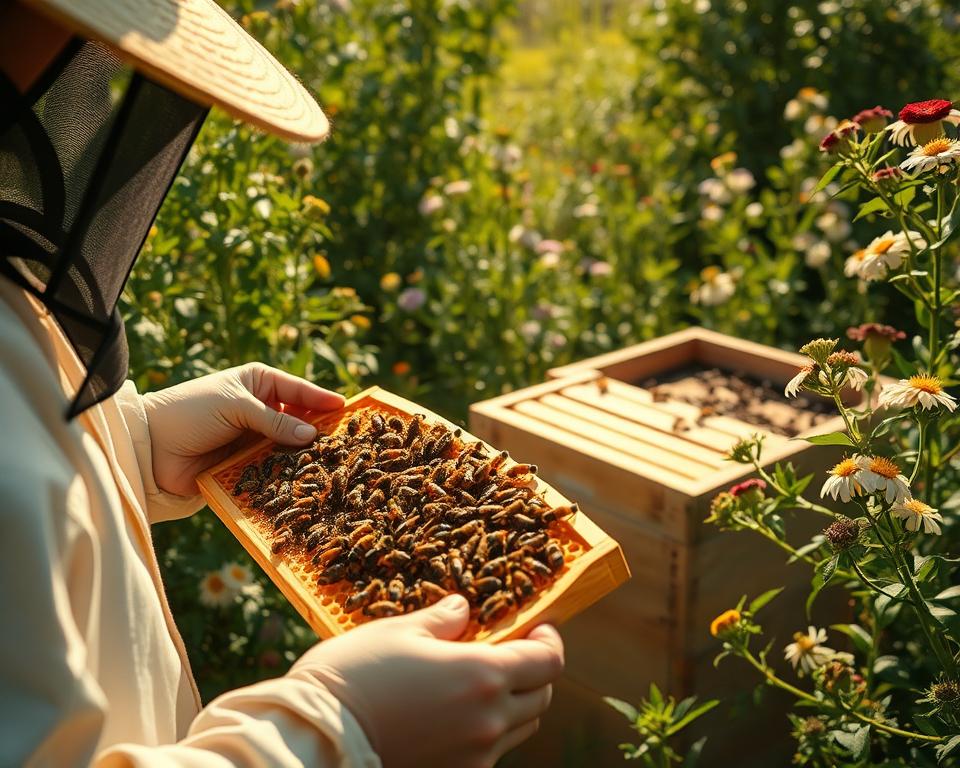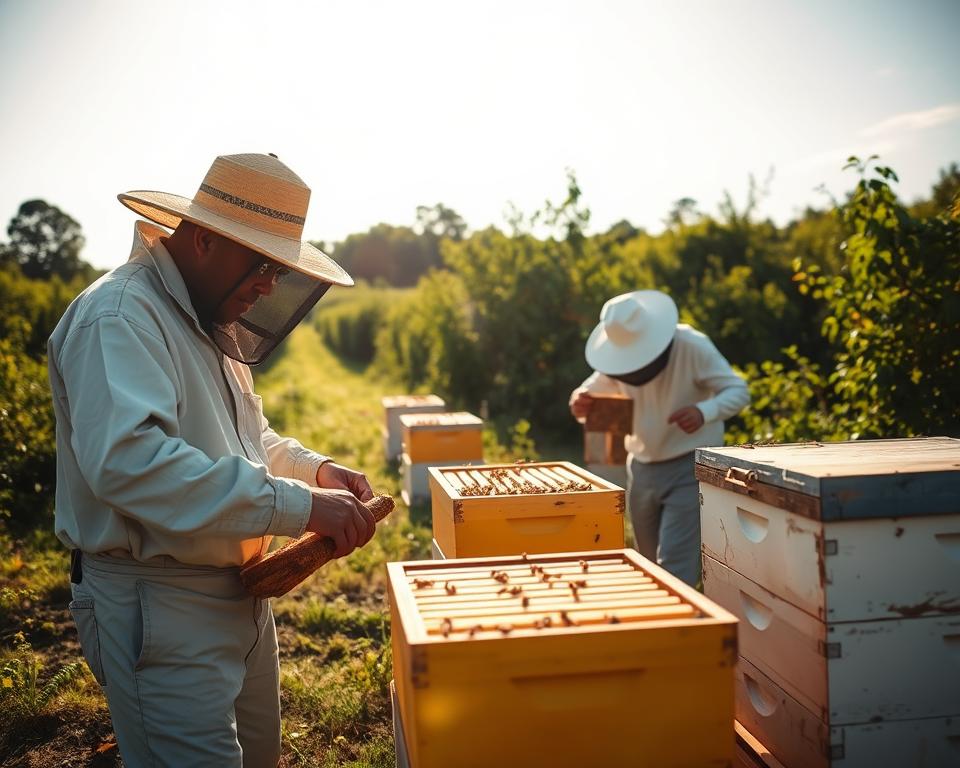As a beekeeper, I’ve learned that dividing hives is key for a healthy apiary. A single hive can make up to 60 pounds of honey per year with the right care. One way to get there is by dividing and multiplying my bee colonies.
This method, called “splitting,” stops swarming and boosts honey making. By splitting hives, I manage the population, lower disease risks, and start new colonies. In this article, I’ll share my tips on how to split your hives right and grow your beekeeping business.
Key Takeaways
- Dividing hives helps prevent swarming and increases honey production.
- Splitting colonies allows for population control and disease reduction.
- Creating new colonies through division can help grow your beekeeping operation.
- Proper hive management is key for a thriving apiary.
- Dividing hives needs careful planning and execution.
Understanding the Basics of Bee Colonies
To split bee colonies successfully, knowing the colony’s structure and health is key. As a beekeeper, I’ve learned that understanding these basics is vital for Colony Division Techniques and Beehive Splitting.
A bee colony is complex, with a queen bee, thousands of worker bees, and drones. The queen lays eggs, while worker bees forage, care for young, and defend the colony. Knowing this social structure helps manage the colony well.
What is a Bee Colony?
A bee colony works as one unit, with each bee important for its survival and productivity. The colony’s strength depends on the queen’s fertility, food availability, and disease or pest presence. As a beekeeper, watching these factors is critical for a thriving colony.
The Importance of Colony Health
Colony health is vital, affecting productivity and survival. A healthy colony fights off diseases and pests better, producing more honey and pollinating crops. Keeping my colonies healthy is a top goal, with regular checks and action when needed.
For colony health, I watch for disease signs, nutritional issues, and pests. This means regular inspections and knowing the colony’s needs. Healthy colonies are strong and productive, making Beehive Splitting more likely to work.
Reasons for Splitting Bee Colonies
Splitting bee colonies is key to stopping swarming and boosting honey production. As a beekeeper, keeping colonies the right size and healthy is vital. This ensures my apiary stays productive.
Preventing Swarming
Splitting colonies stops swarming. Swarming happens when a colony gets too big and splits, losing many bees. By splitting, I control the colony size and prevent loss.
Swarm management is essential. Swarms can cut honey production and spread diseases. Regular checks for overcrowding help manage swarms.
Boosting Honey Production
Splitting colonies also increases honey production. New colonies focus on growing and producing honey. This means more honey for me.
The table below shows how splitting colonies boosts honey production:
| Colony Status | Honey Production Level | Colony Health |
|---|---|---|
| Unsplitted | High | Prone to Swarming |
| Splitted | Very High | Healthy and Balanced |
Splitting colonies helps beekeepers prevent swarming and increase honey. This method, along with swarm management methods, keeps the apiary healthy and productive.
When to Split Your Bee Colony
As a beekeeper, knowing when to split your bee colony is key. It keeps the colony healthy and boosts honey production. Splitting at the right time also prevents swarming and strengthens your apiary.
Seasonal Considerations
The best time to split bee colonies varies with the season. Spring or early summer is ideal. The colony grows fast, and there’s plenty of nectar and pollen. This lets the new colonies get established before summer’s peak.
In areas with mild winters, you can split in late winter. This gives new colonies a jumpstart on the growing season. But, always think about your local climate and nectar flow when choosing the best time.
Signs It’s Time to Split
There are clear signs a colony is ready to be split. Look for multiple queen cells, a big increase in bees, and lots of nectar. Seeing these signs means it’s time to divide the colony.
By watching for these signs and splitting at the right time, you’ll have a successful Queen Bee Separation. Good Beekeeping Colony Split practices make your bees healthier and your apiary more productive.
How to Prepare for Splitting
To make splitting smooth, you need the right equipment and to check the colony’s health. These steps are key for Colony Division Techniques and Beehive Splitting.
Gathering Necessary Equipment
First, get all the needed tools. You’ll need extra hive boxes, frames, foundation, and protective clothes. This makes the process safe and efficient.
- Hive boxes and frames for the new colony
- Protective clothing, including a beekeeping suit and gloves
- Smoker and fuel for calming the bees
- Hive tool for opening the hive and inspecting frames
| Equipment | Purpose |
|---|---|
| Hive Boxes and Frames | To house the new colony and provide space for honey storage and brood rearing |
| Protective Clothing | To protect the beekeeper from stings during the splitting process |
| Smoker and Fuel | To calm the bees by producing smoke, making them less aggressive |
Assessing Colony Strength
Checking the colony’s strength is vital before splitting. Look for a healthy queen, enough food, and a good number of bees.
A strong colony with a healthy queen and plenty of food does well after splitting. I check the frames for disease, pests, and nutrition issues.
Being well-prepared and knowing the colony’s health ensures a successful split. This helps the bees stay healthy.
Step-by-Step Guide to Splitting
Splitting bee colonies is key to keeping bees healthy and stopping swarms. It boosts honey production and keeps your apiary strong.
Choosing the Right Method
First, pick the best method for splitting your colony. You can make a nucleus colony (nuc) or do a full split. A nuc is good for small spaces or limited resources. A full split divides the colony into two, each with its own queen.
Choose based on colony strength, queen availability, and your goals. For fast apiary growth, a full split might be better.
Executing the Split
After picking your method, it’s time to split the colony. You’ll divide the bees and brood combs between the old and new hives. Make sure both have a healthy queen and enough resources.
When dividing, remember to:
- Find the queen and put her in one colony.
- Spread brood combs evenly for healthy growth.
- Give both colonies enough bees to care for the brood.
Monitoring the New Colony
After splitting, watch the new colony closely. Look for disease, pests, and nutrition issues. Make sure the queen is laying eggs and the colony is growing strong.
Be ready to adjust as needed. This might mean feeding or treating for pests and diseases.
By following these steps and choosing wisely, you can split your colony successfully. This will help your apiary thrive.
Ideal Environments for New Colonies
The success of a new bee colony depends on a great environment. As a beekeeper, I know how important the start is. It sets the stage for growth and success.
Selecting a Location
Finding the perfect spot for a new colony is key. It needs lots of sunlight and fresh air to stay healthy. Being close to water is also important for the bees’ drinking needs.

Providing Necessary Resources
It’s important to give the new colony what it needs. This includes lots of flowers for food and safe clothes for the beekeeper. These things help the colony grow strong.
| Resource | Description | Importance |
|---|---|---|
| Nectar-rich flora | Provides food for the colony | High |
| Pollen sources | Essential for brood rearing | High |
| Protective clothing | Safety gear for beekeepers | Medium |
| Water source | Hydration for the bees | High |
By picking the right spot and providing what’s needed, beekeepers help new colonies succeed. This careful planning keeps the bees healthy and productive. It helps the whole apiary thrive.
Aftercare for Split Colonies
After splitting a bee colony, it’s key to care for it well. New colonies might struggle with food or pests. So, watching them closely and fixing problems is important.
Feeding and Nutrition
Feeding the new colony right is a big deal. Bees need nectar, pollen, and honey to stay healthy. If they don’t have enough food, adding sugar syrup or pollen can help.
For more tips on splitting bee colonies, check out this resource.
Pest Management Strategies
Keeping pests away is also vital. New colonies are easy targets for varroa mites, small hive beetles, and wax moths. Using traps and treatments can help fight these pests.
By focusing on food and pest control, beekeepers can help new colonies thrive. This care is vital for their growth and the success of the apiary.
Common Mistakes to Avoid
To make sure split bee colonies thrive, it’s key to know and steer clear of common errors. These mistakes can harm their health and cut down on honey production. When I split my bee colonies, I keep an eye out for issues that might cause swarming or lower honey output.
Overcrowding Issues
One big mistake beekeepers often make is overcrowding their colonies. When a colony gets too packed, it can swarm. This not only cuts down on honey but also risks losing a big part of the colony.
- Monitor colony population regularly
- Ensure adequate space for the colony to grow
- Split colonies before they become too crowded
Neglecting Queen Quality
Another big mistake is ignoring the queen bee’s quality. A healthy, productive queen is key for a new colony’s success. I always check that my queens are top-notch and that the new colony has a strong leader.
Key factors to consider when evaluating queen quality include:
- Age of the queen
- Health and productivity of the queen
- Genetic lineage of the queen
By avoiding these common mistakes, beekeepers can greatly boost their colonies’ health and productivity. Good swarm management methods and careful planning are essential for successful beekeeping.

Expanding Your Apiary Sustainably
As I grow my apiary, I keep my bee colonies healthy and productive. I check on their health often, manage pests and diseases, and make sure I have healthy queens. This way, I can grow my apiary without harming the environment.
Healthy Colonies, Thriving Apiary
I focus on splitting colonies in a way that keeps them healthy. This stops swarming and boosts honey production. Using the right techniques, my colonies stay strong and healthy.
Planning for the Future
When planning for splits, I think about the seasons, nectar, and pests. This helps me make smart choices for my apiary’s future. My goal is to keep my bees and the environment happy and healthy.
